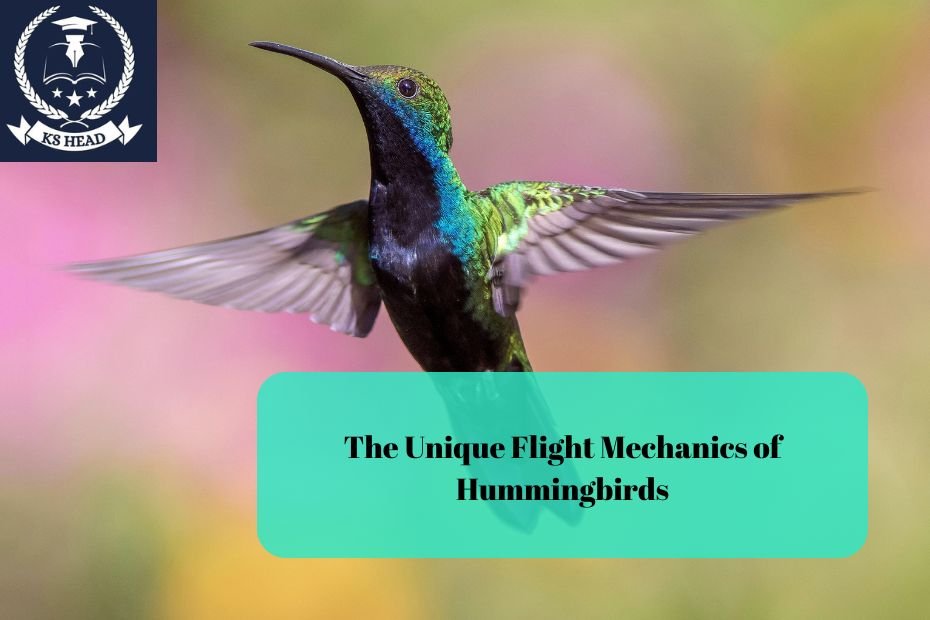Hummingbirds are one of the most fascinating creatures in the avian world. With their tiny size, iridescent feathers, and incredible agility in flight, these birds have captivated birdwatchers, scientists, and nature lovers alike. But beyond their striking appearance, hummingbirds possess a unique set of flight mechanics that sets them apart from other birds. Their ability to hover, fly backward, and rapidly change direction with pinpoint precision makes them one of nature’s most extraordinary fliers.
In this article, we will explore the mechanics behind hummingbird flight, delving into how their wings, muscles, and energy metabolism enable them to perform such acrobatic feats. We will also examine the evolutionary advantages of these flight capabilities and how hummingbirds have adapted to their ecological niches.
Anatomy of Hummingbird Wings
The key to the hummingbird’s extraordinary flight ability lies in its wings. Unlike most birds, which rely on the upstroke and downstroke for propulsion, hummingbirds have a wing structure that allows them to generate lift in both directions. Their wings have a ball-and-socket joint at the shoulder, which allows the wings to rotate almost 180 degrees. This rotation enables them to produce lift on both the downstroke and upstroke, which is crucial for hovering and backward flight.
Feather Structure and Flexibility
Hummingbird feathers are lighter and more flexible than those of other birds, providing less air resistance during rapid movements. The wing’s outermost feathers (primaries) are responsible for most of the thrust, while the inner feathers (secondaries) help control flight stability. The lightweight nature of their feathers allows hummingbirds to achieve high wingbeat frequencies without tiring quickly.
Muscle Adaptation for Rapid Wingbeats
Hummingbirds have specialized flight muscles that make up about 30% of their body weight, which is significantly more than in most birds. These muscles include the pectoralis major, responsible for the downstroke, and the supracoracoideus, which controls the upstroke. The pectoral muscles are highly efficient, providing the strength required to maintain rapid wingbeats, sometimes exceeding 80 beats per second in smaller species. The fast-twitch muscle fibers in these muscles allow hummingbirds to contract and relax their muscles at remarkable speeds, enabling their characteristic rapid wingbeats.
Flight Mechanics: Hovering, Forward, and Backward Flight
Hovering Flight
Hummingbirds are the only birds capable of sustained hovering. While many birds can briefly hover to catch prey or land, hummingbirds can remain stationary in the air for extended periods. This ability is crucial for feeding on nectar from flowers, where precise hovering allows them to extract nectar without touching the flower petals.
In hovering, a hummingbird’s wings move in a figure-eight pattern, generating lift on both the upstroke and downstroke. This flight pattern minimizes the amount of air turbulence, making their hovering stable and efficient. The figure-eight motion helps hummingbirds adjust their body position, allowing them to feed at various angles and orientations.
Forward Flight
When flying forward, hummingbirds can reach speeds of up to 30 miles per hour (48 km/h). They achieve this by tilting their body slightly forward and increasing the angle of their wing strokes. Unlike larger birds, which glide to conserve energy, hummingbirds rely entirely on their wings for propulsion, flapping continuously to generate both lift and thrust. This makes their flight energy-intensive, but their unique wing structure and muscle composition enable them to maintain high-speed flight for short bursts when necessary, such as during courtship displays or territorial disputes.
Backward Flight
Perhaps the most remarkable feature of hummingbird flight is their ability to fly backward. Very few birds can fly in reverse, and none do so with the ease and agility of the hummingbird. To fly backward, hummingbirds rotate their wings in a manner opposite to forward flight. This allows them to move in reverse without altering their body position or stopping their wingbeats. This backward flight capability is especially useful when the bird is feeding and needs to back away from flowers or feeders after extracting nectar.
Sideways and Vertical Movements
In addition to forward and backward flight, hummingbirds can also fly sideways and vertically. This multidirectional flight is made possible by the flexible ball-and-socket joint in their wings, which allows them to adjust their wing orientation and generate lift in nearly any direction. These capabilities enable hummingbirds to navigate through dense foliage and quickly evade predators.
Wingbeat Frequency and Energy Demands
One of the most striking aspects of hummingbird flight is the speed of their wingbeats. While smaller species can beat their wings up to 80 times per second, larger species typically beat their wings around 10 to 15 times per second. The rapid wingbeats are necessary to support their high-speed flight and hovering abilities, but they also demand a tremendous amount of energy.
To sustain such high-energy flight, hummingbirds have evolved incredibly efficient energy metabolism. They have the highest metabolism of any bird, with some species consuming their body weight in nectar and insects daily. This constant intake of food is necessary to fuel their muscles and keep them airborne.
The Role of Heart Rate
Hummingbirds also have the highest heart rate of any bird species, with some species reaching up to 1,200 beats per minute during flight. This rapid heart rate helps circulate oxygen and nutrients to the flight muscles, ensuring they can sustain the energy output required for such demanding movements. At rest, their heart rate slows considerably, allowing them to conserve energy when not in flight.
Torpor: Energy Conservation Strategy
To cope with the immense energy demands of their flight, many hummingbirds enter a state of torpor during the night. Torpor is a temporary reduction in metabolic rate and body temperature, which allows hummingbirds to conserve energy while they sleep. In this state, their body temperature drops dramatically, and their heart rate slows to a fraction of its normal rate, reducing the need for constant feeding.
Evolutionary Advantages of Hummingbird Flight
Hummingbirds’ unique flight capabilities have evolved in response to their ecological niche. Their specialized flight allows them to feed on nectar from flowers that are often inaccessible to other birds. The ability to hover and fly in multiple directions gives them an advantage in accessing food sources located at the tips of branches or deep within flowers. This allows them to occupy a niche that larger, less agile birds cannot exploit.
Additionally, hummingbirds’ high-speed flight and rapid directional changes make them difficult targets for predators. Their agility enables them to evade birds of prey, such as hawks, and smaller predators like snakes and insects. In some species, males use their flight abilities during courtship displays, performing aerial dives and loops to impress potential mates.
Adaptation to High Altitudes
Certain species of hummingbirds are found in high-altitude environments, such as the Andes Mountains, where the air is thin, and oxygen levels are low. These birds have adapted to their environment by developing larger hearts and lungs, which help them extract more oxygen from the air and deliver it to their muscles. Their wingbeat frequency is also adapted to the thinner air, enabling them to maintain flight even in challenging conditions.
Conclusion
The flight mechanics of hummingbirds are a marvel of nature, combining rapid wingbeats, flexible joints, and efficient muscle usage to achieve extraordinary agility. Their ability to hover, fly backward, and rapidly change direction makes them one of the most versatile fliers in the animal kingdom. These adaptations have allowed hummingbirds to carve out a unique ecological niche, feeding on nectar from flowers while evading predators with their incredible speed and precision.
Their flight is not only a testament to the power of evolution but also a source of wonder for anyone who watches them in action. Whether observed in a garden or studied in a laboratory, hummingbirds continue to captivate scientists and nature enthusiasts alike with their unparalleled flight abilities.
FAQs
1. How do hummingbirds hover in place?
Hummingbirds hover by moving their wings in a figure-eight pattern, generating lift on both the upstroke and downstroke. This allows them to remain stationary in the air while feeding on nectar.
2. How fast can hummingbirds fly?
Hummingbirds can fly up to 30 miles per hour (48 km/h) during forward flight and even faster during courtship displays or territorial disputes.
3. What is the highest wingbeat frequency of a hummingbird?
Smaller hummingbird species can beat their wings up to 80 times per second, while larger species typically have a lower wingbeat frequency.
4. Why do hummingbirds need so much energy?
Hummingbirds have a high metabolism due to their rapid wingbeats and constant need to stay airborne. They consume large amounts of nectar and insects to fuel their flight.
5. How do hummingbirds conserve energy during the night?
Many hummingbirds enter a state of torpor at night, slowing their metabolism and lowering their body temperature to conserve energy while they sleep.

